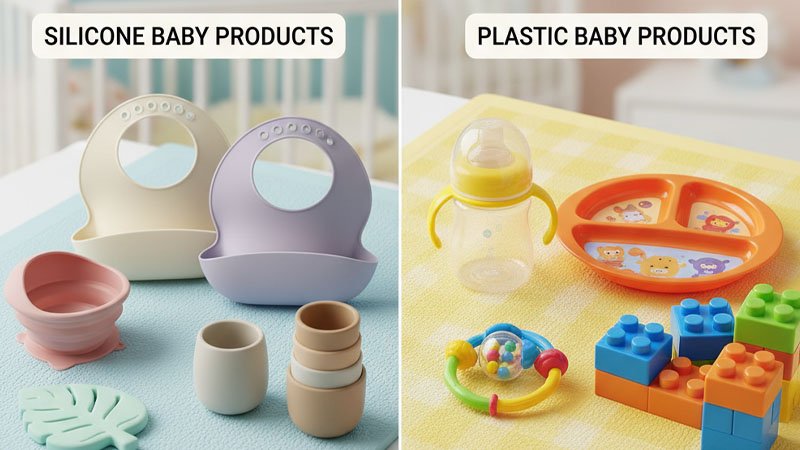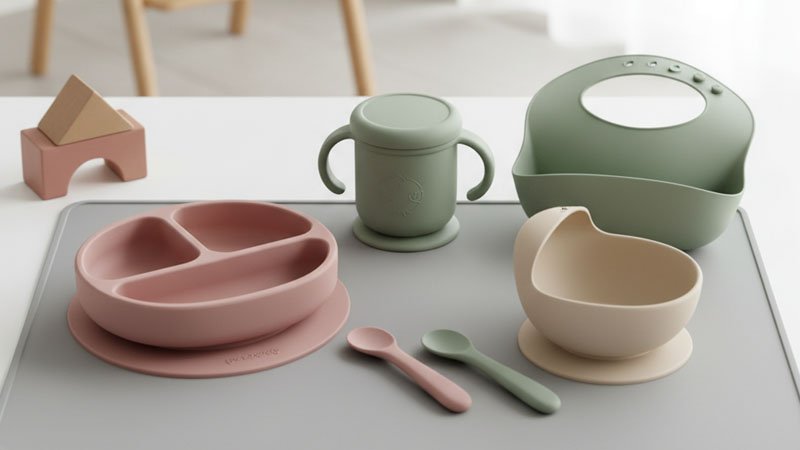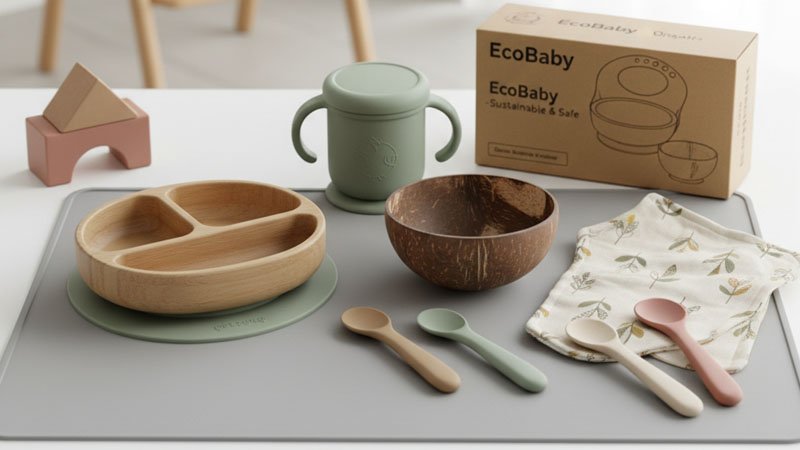Parents worry. From the first spoonful to the last bite, safety and health are always top of mind.
Silicone feeding sets are safe, hygienic, and free from harmful chemicals, making them ideal for babies and toddlers. They’re also durable, easy to clean, and designed for healthy development.
Choosing the right materials for your baby’s feeding time isn’t just about convenience. It’s about trust, peace of mind, and protecting your child’s health. Let’s explore why silicone feeding sets are becoming the top choice for health-conscious parents.
Why is silicone considered safer than plastic?
Parents today are more informed, but the number of options on the market can be overwhelming.
Silicone is non-toxic, BPA-free, and doesn’t leach chemicals like plastic can, even under heat or pressure.

Understanding Material Safety for Babies
Plastic feeding sets have been around for decades. But more studies have shown that many plastics contain or release harmful chemicals like BPA, phthalates, and microplastics—especially when heated in the microwave or dishwasher.
Silicone, by contrast, is a stable material made from silica (sand). It doesn’t react with food, liquids, or heat. Medical-grade and food-grade silicone are tested rigorously for use in baby products. That’s why more pediatricians and product developers recommend silicone over plastic.
Here’s a comparison table of common feeding set materials:
| Material | Chemical Safety | Heat Resistance | Durability | Recyclability |
|---|---|---|---|---|
| Plastic (PP, PS) | Low | Low | Medium | Low |
| Stainless Steel | High | High | High | Medium |
| Glass | High | Medium | Fragile | High |
| Silicone | High | High | High | Medium |
Silicone hits the sweet spot between safety, functionality, and design flexibility. That’s why it’s my top choice when designing new feeding sets.
How does silicone support hygiene and cleanliness?
Food residue, sticky textures, and messy spills make baby feeding time a battlefield.
Silicone is naturally antimicrobial and non-porous, so it resists bacteria buildup and is easier to clean thoroughly.

Cleaning Without Compromise
One of my biggest concerns during product development is how easily baby items can trap food and germs. Plastic and wooden feeding tools often have tiny cracks, grooves, or pores. These can harbor bacteria even after washing. That’s a problem when you’re trying to keep everything sanitary for infants.
Silicone has a smooth, non-porous surface. It doesn’t absorb water or food particles. You can boil it, sterilize it, put it in the dishwasher, or clean it by hand without affecting the material. It also dries faster and doesn’t retain smells.
In some of our designs at RuiYang, we mold silicone in one piece. No seams. No hidden gaps. That makes our feeding sets extra hygienic and safer for daily use.
Here’s a breakdown of cleaning and hygiene features:
| Feature | Silicone Feeding Set | Plastic Feeding Set |
|---|---|---|
| Dishwasher Safe | Yes | Sometimes |
| Can Be Boiled | Yes | No |
| Absorbs Odors/Stains | No | Yes |
| Seamless One-Piece Mold | Yes | Rarely |
Every detail counts when you’re designing for babies. And I believe hygiene is just as important as safety.
Does silicone help support baby development?
Beyond safety, parents also want products that encourage healthy eating habits and motor skills.
Silicone feeding sets are designed to support baby-led weaning, motor skill development, and self-feeding confidence.
Encouraging Independence Through Design
Feeding is more than a daily task. It’s a stage of development. When I work with clients, we look at how the shape, weight, and flexibility of feeding sets affect a child’s learning process.
Silicone utensils are soft and flexible. That means they’re gentle on teething gums. Plates and bowls often come with suction bases to prevent tipping—great for minimizing frustration and promoting confidence during mealtime. Handles are usually sized perfectly for tiny hands.
What I’ve seen is that well-designed silicone sets encourage baby-led weaning. That’s when babies feed themselves with solid food rather than being spoon-fed purees. This approach supports fine motor skills and hand-eye coordination.
Here’s how silicone feeding sets contribute to development:
| Developmental Benefit | Silicone Feature |
|---|---|
| Teething Relief | Soft, chewy texture |
| Motor Skill Development | Easy-grip spoons and forks |
| Mealtime Independence | Suction bases and non-slip surfaces |
| Reduced Mealtime Stress | Durable and safe for self-feeding |
It’s amazing how a thoughtfully designed product can support both parent and child in this important stage.
Are silicone feeding sets environmentally friendly?
Many parents also care about the planet their children will grow up in.
Silicone is more durable and reusable than plastic, making it a more sustainable option for baby feeding products.

Balancing Durability with Sustainability
I often get asked: “Is silicone really eco-friendly?” The answer is yes, but with nuance.
Silicone is not biodegradable like natural rubber, but it is incredibly durable. It doesn’t degrade into microplastics, and it doesn’t need to be replaced often. A single silicone feeding set can last through multiple children or be passed on when no longer needed. That reduces waste in the long run.
Also, many types of silicone can be recycled through specialized facilities. At RuiYang, we work with factories that follow closed-loop systems to reduce manufacturing waste.
And because silicone is oven-safe, microwave-safe, and dishwasher-safe, you don’t need multiple sets for different tasks. Fewer products, less clutter, and reduced consumption.
Here’s how silicone stacks up in eco-friendliness:
| Sustainability Factor | Silicone | Plastic |
|---|---|---|
| Reusability | High | Low |
| Lifespan | Long | Short |
| Biodegradable | No | No |
| Recyclable (special) | Yes | Limited |
| Requires Replacement Often | No | Yes |
So, while it’s not perfect, silicone is a much smarter choice if you’re thinking long-term and eco-conscious.
Conclusion
Silicone feeding sets offer a safe, hygienic, and eco-conscious solution for modern parents focused on their baby’s health and development.